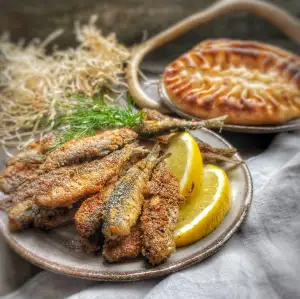Unlocking the Secrets: Mastering the Art of Seasoning a Cast Iron Skillet

- Benefits of Seasoning a Cast Iron Skillet
- Preparing the Skillet for Seasoning
- Choosing the Right Oil for Seasoning
- Step-by-Step Guide to Seasoning a Cast Iron Skillet
- 1 Cleaning the Skillet
- 2 Applying a Thin Layer of Oil
- 3 Heating the Skillet
- 4 Cooling and Storing the Skillet
- Maintaining a Seasoned Cast Iron Skillet
- 1 Cleaning After Use
- 2 Avoiding Harsh Cleaning Agents
- 3 Re-seasoning as Needed
- Troubleshooting Common Seasoning Issues
- 1 Sticky Residue
- 2 Rust Formation
Seasoning a cast iron skillet is an essential skill for any aspiring chef. This process involves creating a protective layer on the surface of the skillet, which not only prevents rust but also enhances its non-stick properties. By mastering this art, you can unlock the full potential of your cast iron skillet and elevate your cooking to new heights. In this article, we will explore the benefits of seasoning, how to prepare the skillet, choose the right oil, and provide a step-by-step guide to achieve perfect seasoning. So let's dive in and uncover the secrets of mastering the art of seasoning a cast iron skillet!
Benefits of Seasoning a Cast Iron Skillet
Seasoning a cast iron skillet offers numerous benefits. Firstly, it creates a natural non-stick surface, making cooking and cleaning easier. This means you can use less oil or butter when cooking, resulting in healthier meals. Additionally, the seasoning process enhances the skillet's durability and prevents rust formation. The seasoned surface also improves heat distribution, ensuring even cooking and preventing hot spots. Lastly, a well-seasoned cast iron skillet adds depth and flavor to your dishes, enhancing the overall culinary experience.
Preparing the Skillet for Seasoning
Before seasoning your cast iron skillet, it is essential to prepare it properly. Start by washing the skillet with warm water and mild dish soap to remove any dirt or debris. Use a stiff brush or sponge to scrub away any stubborn residue. Rinse the skillet thoroughly and dry it completely using a clean towel or by placing it on a low heat burner for a few minutes. Make sure there is no moisture left on the surface as this can lead to rust formation during the seasoning process. Once the skillet is dry, you are ready to move on to the next step of seasoning.
Choosing the Right Oil for Seasoning
Choosing the right oil for seasoning is crucial to achieve a perfectly seasoned cast iron skillet. The best oils for this purpose are those with a high smoke point, such as vegetable oil, canola oil, or flaxseed oil. These oils can withstand high temperatures without breaking down or becoming rancid. Avoid using oils with low smoke points, like olive oil or butter, as they tend to burn and create a sticky residue on the skillet's surface. It's important to choose an oil that will create a durable and non-stick seasoning layer, ensuring optimal cooking performance and easy food release.
Step-by-Step Guide to Seasoning a Cast Iron Skillet
1. Cleaning the Skillet: Start by scrubbing the skillet with hot water and a stiff brush to remove any dirt or debris. Avoid using soap, as it can strip away the seasoning.
2. Applying a Thin Layer of Oil: Once the skillet is clean and dry, apply a thin layer of oil all over its surface. Use a high-smoke point oil like vegetable oil or flaxseed oil.
3. Heating the Skillet: Place the oiled skillet upside down in an oven preheated to 350°F (175°C). Let it bake for about one hour to allow the oil to polymerize and create a non-stick coating.
4. Cooling and Storing the Skillet: After baking, turn off the oven and let the skillet cool completely inside before removing it. Store it in a dry place to prevent moisture from causing rust.
Remember, seasoning is not a one-time process; repeat these steps several times to build up a durable seasoning layer that enhances your cooking experience.
1 Cleaning the Skillet
Cleaning the skillet is an important step in the seasoning process. Start by rinsing the skillet with hot water and using a stiff brush to remove any food particles or residue. Avoid using soap, as it can strip away the seasoning. If there are stubborn bits stuck to the skillet, you can use a small amount of coarse salt as a scrubbing agent. Rinse thoroughly and dry completely with a clean towel or by placing it on low heat on the stove for a few minutes.
2 Applying a Thin Layer of Oil
To apply a thin layer of oil to your cast iron skillet, start by heating the skillet on the stovetop until it is warm. Then, using a paper towel or cloth, apply a small amount of oil to the surface of the skillet. Make sure to cover all areas, including the sides and handle. Use a circular motion to evenly distribute the oil. Be careful not to use too much oil as this can lead to a sticky residue. Once the skillet is coated with oil, allow it to cool completely before moving on to the next step.
3 Heating the Skillet
3. Heating the Skillet
Once you have applied a thin layer of oil to your cast iron skillet, it is time to heat it. This step is crucial as it helps the oil penetrate the pores of the skillet, creating a non-stick surface.
Place the skillet on a stovetop burner set to medium-high heat. Allow the skillet to heat up gradually for about 5 minutes. This will ensure that the oil evenly coats the entire surface of the skillet.
During this heating process, you may notice some smoke or a slight odor. This is normal and indicates that the seasoning process is taking place. However, if you notice excessive smoke or a strong unpleasant smell, reduce the heat immediately as this could be a sign of overheating.
After heating for 5 minutes, use tongs or oven mitts to carefully remove the skillet from the heat source. Allow it to cool completely before proceeding to the next step.
Heating your cast iron skillet not only helps in creating a durable non-stick surface but also enhances its ability to distribute heat evenly, resulting in perfectly cooked meals every time.
4 Cooling and Storing the Skillet
After heating the skillet, it is important to allow it to cool completely before storing. This will prevent any moisture from getting trapped and causing rust. Once cooled, gently wipe away any excess oil with a paper towel. Avoid using water or soap as this can remove the seasoning. Store the skillet in a dry place with good air circulation to prevent any moisture buildup. If stacking multiple skillets, place a paper towel between each one to avoid scratching the seasoning. Proper cooling and storage will help maintain the integrity of the seasoned surface and ensure your cast iron skillet lasts for generations to come.
Maintaining a Seasoned Cast Iron Skillet
Maintaining a seasoned cast iron skillet is essential to ensure its longevity and optimal cooking performance. Here are some key steps to follow:
6.1 Cleaning After Use: After each use, gently scrub the skillet with a soft brush or sponge and warm water. Avoid using soap as it can strip away the seasoning.
6.2 Avoiding Harsh Cleaning Agents: Harsh cleaning agents like bleach or abrasive cleaners should never be used on a seasoned cast iron skillet. These can damage the seasoning and affect the flavor of your food.
6.3 Re-seasoning as Needed: Over time, the seasoning on your skillet may wear off or become uneven. If you notice food sticking to the surface or rust forming, it's time to re-season. Simply repeat the seasoning process outlined earlier to restore its non-stick properties.
By following these maintenance practices, you'll be able to enjoy the benefits of a well-seasoned cast iron skillet for years to come.
1 Cleaning After Use
Cleaning After Use:
After using your cast iron skillet, it's important to clean it properly to maintain its seasoning. Start by removing any food residue with a gentle scrub brush or sponge. Avoid using harsh abrasive cleaners that can strip away the seasoning.
If there are stubborn bits stuck to the skillet, you can add a small amount of coarse salt and scrub gently. Rinse the skillet with warm water, making sure to remove all traces of soap.
Once cleaned, dry the skillet thoroughly with a towel or by placing it on low heat on the stovetop. Moisture is the enemy of cast iron, as it can lead to rust formation.
To prevent rust and maintain the seasoning, apply a thin layer of oil to the entire surface of the skillet after cleaning. This will help protect it until your next use.
By following these simple steps, you can ensure that your cast iron skillet remains in top condition and continues to provide you with deliciously seasoned meals for years to come.
2 Avoiding Harsh Cleaning Agents
6.2 Avoiding Harsh Cleaning Agents
When it comes to cleaning a seasoned cast iron skillet, it's important to avoid using harsh cleaning agents. These can strip away the protective seasoning layer and leave your skillet vulnerable to rust and food sticking. Instead, opt for gentle cleaning methods.
Firstly, avoid using soap when washing your skillet. Soap can break down the seasoning and remove its non-stick properties. Instead, use hot water and a stiff brush or sponge to gently scrub away any food residue.
Additionally, avoid using abrasive materials such as steel wool or metal scrubbers. These can scratch the surface of the skillet and damage the seasoning. Instead, use a soft cloth or nylon brush to clean the skillet.
If there are stubborn bits of food stuck to the skillet, you can create a paste with coarse salt and water. Gently scrub this paste onto the surface of the skillet using a cloth or brush to help loosen the stuck-on food.
By avoiding harsh cleaning agents and opting for gentle methods, you can ensure that your seasoned cast iron skillet remains in optimal condition for years to come.
3 Re-seasoning as Needed
Re-seasoning a cast iron skillet is necessary when the seasoning starts to wear off or when there are signs of rust. To re-season, start by cleaning the skillet thoroughly with hot water and a stiff brush. Avoid using soap as it can strip away the seasoning. Once clean, dry the skillet completely.
Next, apply a thin layer of oil all over the skillet, including the handle and exterior. Use a high smoke point oil like vegetable oil or flaxseed oil. Make sure to coat every inch of the skillet to ensure an even seasoning.
Place the skillet upside down in a preheated oven at 375°F (190°C) for one hour. This allows the oil to polymerize and create a protective layer on the surface of the skillet. After an hour, turn off the oven and let the skillet cool inside.
Once cooled, your cast iron skillet is ready to use again. The re-seasoning process helps restore its non-stick properties and prevents rust formation. Remember to repeat this process as needed to maintain a well-seasoned skillet that will last for years to come.
Troubleshooting Common Seasoning Issues
7. Troubleshooting Common Seasoning Issues
7.1 Sticky Residue: If you notice a sticky residue on your cast iron skillet after seasoning, it may be due to excess oil or improper heating. To fix this issue, simply heat the skillet again on low heat until the residue evaporates and wipe it clean with a paper towel.
7.2 Rust Formation: Rust can occur if your cast iron skillet is not properly seasoned or if it has been exposed to moisture. To remove rust, scrub the affected area with a stiff brush or steel wool. Then, re-season the skillet by applying a thin layer of oil and heating it in the oven.
Remember, troubleshooting seasoning issues is part of the journey to mastering the art of seasoning a cast iron skillet. With practice and patience, you'll be able to enjoy all the benefits of a well-seasoned skillet in no time!
1 Sticky Residue
7.1 Sticky Residue
Sometimes, despite our best efforts, a sticky residue can form on the surface of a cast iron skillet after seasoning. This can happen if too much oil is applied or if the oil is not properly heated and polymerized during the seasoning process.
To remove sticky residue, start by heating the skillet over medium heat for a few minutes. Then, using a paper towel or cloth, gently scrub the surface to loosen the residue. If necessary, you can also use a plastic scraper or a non-abrasive brush.
Next, rinse the skillet with hot water and dry it thoroughly. Avoid using soap as it can strip away the seasoning layer. If there are still traces of sticky residue, you can repeat this process or use a small amount of coarse salt as an abrasive to help remove it.
Once the residue is completely removed, reapply a thin layer of oil to the skillet and heat it again until it reaches its smoking point. This will help to reseal and strengthen the seasoning layer.
By addressing any sticky residue promptly and effectively, you can ensure that your cast iron skillet remains in optimal condition for cooking delicious meals for years to come.
2 Rust Formation
7.2 Rust Formation
One of the main concerns when it comes to cast iron skillets is rust formation. If not properly cared for, moisture can cause the skillet to develop rust spots, which can affect the quality of your cooking and even lead to health hazards.
To prevent rust formation, it's essential to store your cast iron skillet in a dry place. Moisture is the enemy here, so make sure the skillet is completely dry before storing it. You can achieve this by thoroughly drying it with a clean cloth or paper towel after cleaning.
If you notice any signs of rust on your skillet, don't panic! It can be easily remedied. Start by scrubbing off the rust using a gentle abrasive, such as steel wool or a scrub brush. Once all the rust has been removed, rinse the skillet with warm water and dry it thoroughly.
Next, apply a thin layer of oil to the skillet and heat it over low heat for about 10 minutes. This will help re-season the skillet and create a protective barrier against future rust formation.
Remember, prevention is key when it comes to rust formation. Avoid leaving acidic or salty foods in your cast iron skillet for extended periods as they can accelerate rusting. Additionally, never soak your skillet in water or leave it wet for too long.
By following these tips and maintaining proper care, you can enjoy all the benefits of a well-seasoned cast iron skillet without worrying about rust formation.
In conclusion, mastering the art of seasoning a cast iron skillet is essential for any aspiring chef or home cook. By properly seasoning your skillet, you unlock a world of benefits such as enhanced non-stick properties, improved heat distribution, and increased durability.
A well-seasoned cast iron skillet becomes a versatile tool in your kitchen, allowing you to cook a wide range of dishes with ease. From perfectly seared steaks to crispy fried chicken, this seasoned skillet will elevate your culinary creations to new heights.
Not only does seasoning enhance the cooking performance of your skillet, but it also adds depth and flavor to your dishes. The layers of oil build up over time create a natural non-stick surface that enhances the taste and texture of your food.
Additionally, a well-seasoned cast iron skillet requires minimal maintenance. With proper cleaning and occasional re-seasoning, your skillet will last for generations. It becomes an heirloom piece that can be passed down through the family, preserving memories and flavors for years to come.
So don't hesitate to unlock the secrets of seasoning a cast iron skillet. With patience and practice, you'll soon be enjoying the many benefits that come with mastering this culinary technique. Happy cooking!
Published: 27. 11. 2023
Category: Food



